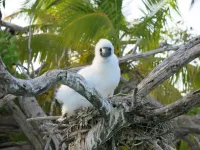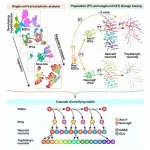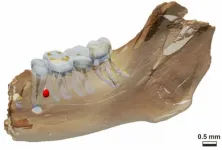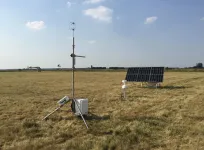(Press-News.org) Scientists have provided the first evidence to show that eradicating rats from tropical islands effects not just the biodiversity on the islands, but also the fragile coral seas that surround them.
The new study led by scientists at Lancaster University and published in the journal Current Biology shows that critical cycles of seabird nutrients flowing to coral reefs are re-established within relatively short time periods after rats are removed - even around islands that have been infested for hundreds of years.
The findings offer encouragement that rat eradication can benefit coral reefs, because these nutrient flows can bolster the health of delicate coral reef ecosystems and may improve their chances of rebounding between climate disturbance events.
Seabirds are a critically important distributor of nutrients for island and marine environments. They feed on fish often in the open ocean far from islands, and then return to islands to roost - depositing nitrogen-rich nutrients on the island in the form of guano - or poo. Some of the guano is then leached off the islands by rain and into the surrounding seas where the nitrogen fertilises corals and other marine species such as algae and sponges, boosting the food-chain.
However, over the last several centuries people introduced rats to many tropical islands through settlement, sailing between islands and shipwrecks. Rats are a very damaging invasive species, consuming the seeds of many plants, and devastating bird populations as they eat eggs, chicks, and even adults of the smallest seabird species.
Previous studies by scientists from the same research team revealed that islands with rat infestations had much smaller seabird populations than islands without rats, and as a result, there was much less nitrogen on the islands, and in the surrounding marine environments. This results in significant knock-on negative effects with less reef fish biomass, reduced ecosystem functioning, and slower coral growth on adjacent coral reefs.
In this latest study the researchers looked at 20 islands in the central and western Indian Ocean, including the Chagos Archipelago and the Scattered islands. These remote and protected islands provided an ideal testbed as they contain islands with varying rat histories.
By comparing rat infested islands with islands where invasive rat populations have been eradicated, and islands that have never had rats, they found that the greatest number of seabirds, and the nutrients they provide to island and marine ecosystems were at the islands where rats have never been introduced. Those islands that have existing rat infestations had the fewest seabirds, and seabird-derived nutrients. Importantly, they found islands where rats had been eradicated were between the two.
Seabird populations are steadily increasing on two islands within the Scattered Islands - Île du Lys and Tromelin.
"Rats were eradicated on Tromelin in 2005," said Matthieu Le Corre of the Universite de La Reunion who was part of the research team. "Since then there has been an eight-fold increase in seabirds, and six species that were locally extinct because of the rats have restarted to breed after rat eradication. On Île du Lys, where rats were eradicated in 2003, surveys show there has been a ten-fold increase in seabirds since."
The researchers, testing fish and algae, also found increased measurements of seabird-derived nitrogen in the marine ecosystems surrounding these islands.
These results show that even after hundreds of years of rat infestations, the islands and the surrounding marine ecosystems can start to recover within 16 years of rat eradication.
Dr Casey Benkwitt, of Lancaster University and lead author of the research, said: "We know that rats are devastating for island seabird populations, and that the loss of these birds from islands is harmful to the surrounding coral reef ecosystems. However, we needed to test whether removing the rats from islands could help these important nutrient cycles return, and if so, how quickly and how far the benefits would spread onto fragile coral reefs.
"Our study shows the first evidence that rat eradication programmes can indeed be an important tool in helping restore these vital seabird-led nutrient cycles not just on tropical islands themselves, but also in their surrounding seas - and that they can recover within relatively short timeframes, which is very encouraging."
However, not all of the marine ecosystem functions around islands that have had rats eradicated have improved. One important measure, that of the growth and size of coral reef fish, was not higher around these islands. Fish do grow faster adjacent to islands that have never had rats present, so these benefits may take longer to emerge following rat eradication.
The findings will help guide management and restoration efforts for islands and coral reef environments. The researchers believe that by combining rat eradication programmes with other restoration strategies it could be possible to speed-up the recovery of seabird populations, and their benefits to surrounding marine environments.
Professor Nick Graham, of Lancaster University and Principal Investigator of the research, said: "This study adds to the weight of evidence suggesting rat eradication can have substantial conservation benefits to tropical island and adjacent marine ecosystems. The nutrient cycles that returning seabirds bring can bolster coral and fish assemblages. With climate impacts severely impacting coral reefs, management actions to boost the ecosystem are incredibly important."
INFORMATION:
The paper's authors are: Cassandra Benkwitt, Rachel Gunn and Nick Graham of Lancaster University; Matthieu Le Corre, of Université de La Reunion; Peter Carr of the ZSL (Zoological Society of London) and the University of Exeter.
DOI: 10.1016/j.cub.2021.03.104
What The Study Did: Researchers looked at whether short-term exposure to air pollution from a 2018 California wildfire was associated with changes in the number of clinic visits for eczema or itch and medications prescribed for eczema.
Authors: Maria L. Wei, M.D., Ph.D., of the University of California, San Francisco, is the corresponding author.
To access the embargoed study: Visit our For The Media website at this link https://media.jamanetwork.com/
(doi:10.1001/jamadermatol.2021.0179)
Editor's Note: The article includes conflicts of interest and funding/support disclosures. Please see the article for additional information, including other authors, author contributions and affiliations, conflict of interest and financial disclosures, ...
Wildfire smoke can trigger a host of respiratory and cardiovascular symptoms, ranging from runny nose and cough to a potentially life-threatening heart attack or stroke. A new study suggests that the dangers posed by wildfire smoke may also extend to the largest organ in the human body, and our first line of defense against outside threat: the skin.
During the two weeks in November 2018 when wildfire smoke from the Camp Fire choked the San Francisco Bay Area, health clinics in San Francisco saw an uptick in the number of patients visiting with concerns of eczema, also known as atopic dermatitis, and general itch, compared to the same time of the year ...
A mechanistic understanding of brain development requires a systematic survey of neural progenitor cell types, their lineage specification and maturation of postmitotic neurons. Cumulative evidences based on single-cell transcriptomic analysis have revealed the heterogeneity of cortical neural progenitors, their temporal patterning and the developmental trajectories of excitatory and inhibitory neurons in the developing neocortex. Nevertheless, the developmental hierarchy of the hypothalamus, which contains an astounding diversity of neurons that regulate endocrine, autonomic and behavioral functions, has not been well understood.
Recently, however, Prof. WU Qingfeng's ...
WHO Peter Libby, MD, cardiovascular medicine specialist at Brigham and Women's Hospital and the Mallinckrodt Professor of Medicine at Harvard Medical School; author of a new review paper published in Nature.
WHAT Atherosclerosis -- hardening of the arteries -- is now involved in the majority of deaths worldwide, and advances in our understanding of the biology of the disease are changing traditional views and opening up new avenues for treatment.
The picture of who may be at risk for a heart attack has evolved considerably in recent decades. At one time, a heart attack might have conjured up the image of a middle-aged white man with high cholesterol and high blood pressure who smoked cigarettes. Today, traditional concepts of what contributes to risk have changed. These ...
In 2016, an inflatable arch wreaked havoc at the Tour de France bicycle race when it deflated and collapsed on a cyclist, throwing him from his bike and delaying the race while officials scrambled to clear the debris from the road. Officials blamed a passing spectator's wayward belt buckle for the arch's collapse, but the real culprit was physics.
Today's inflatable structures, used for everything from field hospitals to sporting complexes, are monostable, meaning they need a constant input of pressure in order to maintain their inflated state. Lose that pressure and the structure ...
What is the cost of 1 ton of a greenhouse gas? When a climate-warming gas such as carbon dioxide or methane is emitted into the atmosphere, its impacts may be felt years and even decades into the future - in the form of rising sea levels, changes in agricultural productivity, or more extreme weather events, such as droughts, floods, and heat waves. Those impacts are quantified in a metric called the "social cost of carbon," considered a vital tool for making sound and efficient climate policies.
Now a new study by a team including researchers from Lawrence Berkeley National Laboratory (Berkeley Lab) ...
Despite our efforts to sort and recycle, less than 9% of plastic gets recycled in the U.S., and most ends up in landfill or the environment.
Biodegradable plastic bags and containers could help, but if they're not properly sorted, they can contaminate otherwise recyclable #1 and #2 plastics. What's worse, most biodegradable plastics take months to break down, and when they finally do, they form microplastics - tiny bits of plastic that can end up in our oceans, fish, and even our bodies.
Now, as reported in the journal Nature, scientists at the Department ...
A study that appeared today on Current Biology sheds new light on the continental migrations which shaped the genetic background of all present Europeans. The research generates new ancient DNA evidence and direct dating from a fragmentary fossil mandible belonging to an individual who lived ~17,000 years ago in northeastern Italy (Riparo Tagliente, Verona). The results backdate by about 3,000 years the diffusion in Southern Europe of a genetic component linked to Eastern Europe/Western Asia previously believed to have spread westwards during later major warming shifts.
"By looking into the past of this particular individual, ...
Astronomers using data from NASA and the ESA (European Space Agency) telescopes have released a new all-sky map of the outermost region of our galaxy. Known as the galactic halo, this area lies outside the swirling spiral arms that form the Milky Way's recognizable central disk and is sparsely populated with stars. Though the halo may appear mostly empty, it is also predicted to contain a massive reservoir of dark matter, a mysterious and invisible substance thought to make up the bulk of all the mass in the universe.
The data for the new map comes from ESA's Gaia mission and NASA's Near Earth Object Wide Field Infrared Survey Explorer, or NEOWISE, which operated from 2009 to 2013 under the moniker WISE. The study, led by astronomers at the Center for ...
Substantial cuts in global greenhouse gas emissions could be achieved by raising water levels in agricultural peatlands, according to a new study in the journal Nature.
Peatlands occupy just three per cent of the world's land surface area but store a similar amount of carbon to all terrestrial vegetation, as well as supporting unique biodiversity.
In their natural state, they can mitigate climate change by continuously removing CO2 from the atmosphere and storing it securely under waterlogged conditions for thousands of years.
But many peatland areas have been substantially modified by human activity, including drainage for agriculture and forest plantations. This results in the ...





